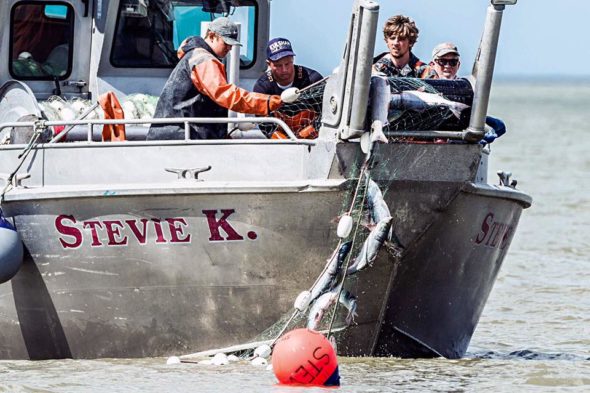
Jawanza Brown recalled the time Seahawks RB Thomas Rawls spoke to the Boys & Girls Club in their hometown of Flint, Mich. Rawls was playing football at the University of Michigan, Brown was a star-struck kid.
“I remember he talked about pushing through adversity by saying, ‘I was built for this,'” Brown said by phone the past week. “That quote stuck in my head. I’m keeping that in mind this summer.”
Brown wants to prove he is built for something too: Crewing on a 32-foot gillnetter in Bristol Bay, Alaska, home to the world’s largest, most intense salmon fishery.
Even though he’s never done such a thing. Even though he’s never been on a commercial boat. Even though he’s left the state of Michigan but once — to Ohio.
Hell, he hasn’t even been on a plane.
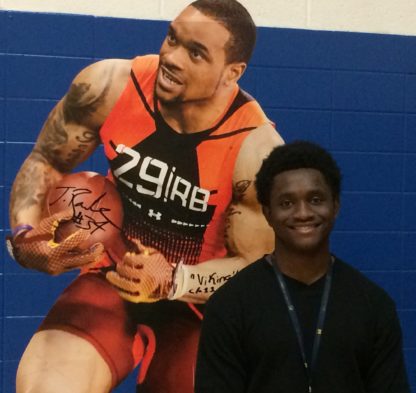
His first flight is Tuesday, two days after his Sunday graduation from Flint’s Powers Catholic High School: From Detroit to Seattle to Anchorage to the airport at King Salmon, Brown will travel from one bleak American outpost to another.
The difference being, on the Stevie K boat owned and operated by Buck Gibbons of Bellingham, Brown has a chance to do something he could not do in Flint — earn enough money in a couple of months to pay for a year of college at Saginaw Valley State University, where he’s been accepted for enrollment.
The difference also being, he might be the only African-American in a fleet of more than 150 boats bouncing gunwale to gunwale in the turbulent North Pacific.
“From an anecdotal perspective, there are practically zero African-American crew members,” Gibbons said. “There is not too much diversity in the fish-catching business.”
What is certain is that Brown is the only guy in the fleet whose place was secured by the audacious inspiration of Gibbons. He was taken by the backstory of Rawls, the Seahawks’ undrafted free agent who aspires to supplant in Seattle an NFL legend, Marshawn Lynch, and who mentions pridefully his desperate hometown in nearly every interview the way Lynch talked of Oakland.
Gibbons sought someone like Rawls. Not a one-in-a-million athlete, but a young man equally ambitious and in no less need of someone to believe in him.
“I’m not trying to help support a life,” Gibbons said over lunch in downtown Seattle recently. “I’m trying to get guys from the back seat to the front seat. After summers on the boat in their college years, they get on a career path and can wave goodbye to the boat.
“The income from this summer job can be profound.”
How profound? The least-experienced newbies who finish out a good season in Bristol Bay can make up to $15,000. Annual tuition at Sag Valley is $8,300.
Also profound is the workload — 12-hour days of pulling fish from nets, repairing gear, preparing meals, cleaning decks, listening to snoring, bad jokes and aggravating music of three strangers who must instantly work as a team.
And do all of that often on four hours’ sleep. Brown is a little concerned.
“I love sleep — today I slept about 12 hours,” he said, laughing. “There’s a lot of work on the boat, but sleep is a priority. Sometimes you sleep only a few hours, then get up again. I’m pretty sure I can do it.”
But it all will be so . . . different. Just imagine all those white people.
“It’s not that big a deal, but I want to be sure to keep my focus,” he said, “because there’s lots of things going on on the boat. And I wonder how it’s going to be on the boat, and how I’ll adjust.”
That’s the great thing about Alaska. And fishing for a living. It’s full of risk and reward. You never know.
Gibbons has been in love with commercial fishing since he graduated from Washington State University. He had ambition to become an FBI agent, but one summer fishing trip with his brother-in-law to Bristol Bay convinced him a better working life was found aboard a boat.

Gibbons, who grew up in Valdez, Alaska, bought his first boat in 1980 and has been been making a good living since. He liked finding crew members among high school athletes who needed good jobs to get through college. He discovered that wrestlers were often best suited by skill and disposition for the work. And Sehome High School’s wrestling program provided several crew members for a decade.
But as a guy with a social conscience, he thought about giving a chance to an African American teenager. Just because he prefers to walk his talk.
“I decided,” he said, “to get out of my comfort zone.”
He made inquiries with school administrators and coaches in the Seattle and Tacoma school districts, but found no takers. Well, there was one. When a coach in Tacoma heard about the money and work, he said he’d take the job.
“No,” Gibbons said dismissively. “This is for kids.”
So he searched out of the area. He tried to reach officials in Baltimore. No one was buying Gibbons’ preposterous idea of plucking a kid out of the inner city and plopping him into a sprawling outdoor drama at the edge of the earth.
Then he read a story and saw a video, and thought he’d try his long shot again.
In 2016, the Seattle Times sent reporters Jayson Jenks and Bettina Hansen to Flint to profile Rawls’ upbringing in one of America’s most impoverished cities. Flint has become a metaphor for the wrong end of the American dream. From the abandonment by the auto-manufacturing industry to the water crisis that created a national political uproar, many have heard of Flint, and not in good way.
Rawls takes his responsibility to his hometown so seriously that his mother worries her son worries too much about the hometown. Rawls is undeterred.
“I want,” Rawls told reporters in January 2016, “to be Superman for my city.”
Gibbons read the compelling Times story in October, watched the video and starting making calls.
Stacy Winchester had been a high school football coach in Georgia for two years when he returned to Flint in 2010, just after Rawls’ senior season at Flint’s Northern High School. In his new job as program coordinator for Flint Boys & Girls Club, Winchester became acquainted with Rawls, who was frequently at the club before he left for college.
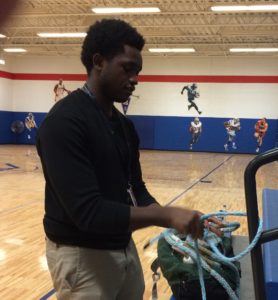
“He was always here,” Winchester said by phone. “The younger kids loved him.”
In late winter, Winchester received a call from a guy up near Seattle who wanted to give the right kid in Flint a good-paying job fishing in Alaska.
“Fishing in Alaska? That’s something we watch on A&E,” Winchester recalled thinking. “This is not something that happens to one of our kids in this city.”
But the more Winchester read and heard, the more this Gibbons guy sounded for real. Gibbons sent along photos, documents and stories about him and the Alaska experience.
“It took time, and fish don’t have calendars, but I just had to stay on it,” Gibbons said, eager to pull together a crew before he left last week for Bristol Bay. “I did quite a bit of back and forth with Stacy, because I didn’t want to overwhelm him.”
Then came the call from Winchester.
“I got just the young man for you,” he told Gibbons.
“Good, “Gibbons said. “I’m catching a plane to Flint.”
This is not a hire done only by phone.
Advocates for Flint, a city a little bigger (102,000) than Bellingham, say it has fallen into astonishing neglect because it is mostly black and mostly poor. That’s part of how its residents came to be poisoned by the city’s water supply.
It’s called environmental racism.

Gibbons can’t do much about the scandal. Nor could he speak right away when I asked him about his trip to Flint.
His eyes welled. For more than 30 seconds, he stared out of the restaurant window.
“When I got there . . .” he said, pausing again. “I couldn’t believe the poverty. I don’t think many people move to Flint. I’ve never seen so much commercial property boarded up and surrounded by barbed wire. The car companies employed 80,000 there once. Now it’s 5,000.
“The idea went beyond fishing to emotional and social. Not just catch fish, cash check. Jawanza is one of six children of a single mother who’s a hairdresser. You start see what their normal is and what we consider normal. I wasn’t ready for it.”
Nor is Brown likely to be ready for Bristol Bay. Broken shards of comfort zones are all over this story.
That is why Gibbons had to meet Brown. Even though Brown’s friends were excited for him, they too, wished for such a chance. But as Winchester explained the selection, a group decision that relied on parents, teachers, coaches and club personnel, the choice wasn’t too hard.
“Buck’s requirements were to have plans to go to college for four years and to come fishing for all four summers,” Winchester said. “That speaks to a particular kind of person: Somebody who’s resilient, persistent, somebody who’s going to face a challenge and not give up. College is a big task. You have to really be responsible. The candidates got fewer as the requirements were laid out.
“When I looked at the available kids, Jawanza stood out. Really good kid, good student, works hard and was already one of our scholarship students at Powers Catholic, a private school. When I asked him if he was interested, he got extremely excited.
“One of the first things he said was, ‘Man, I’m gonna be able to pay for school. And man, I love to fish.'”
Gibbons met with directors of the Boys & Girls Club, and with Brown’s mother, Erika, and father, also Jawanza. He had talked by phone with his apprentice crewman a few times, but met in Flint for first time over breakfast, alone. Then they drove to the club. Gibbons was packing a duffel bag full of fishing gear, the kind of stuff that would be a fixture of Brown’s summer.
“I held off the bulk of the job description until then,” Gibbons said. “I wanted him familiar with tying knots, and I brought a small net. We went on the gym floor and spread the net, acclimating him to the extent I could.
“He’s a smart kid. Caught on fast.”
After Winchester let them in the gym and went to his office to work, he couldn’t help but overhear some of the conversation.
“There’s no pep talk going on, no motivational speech,” Winchester said. “What I was hearing was, ‘Here’s what’s expected,’ and ‘Yes, sir,’ for a couple of hours. Buck knows what’s going on. He knows how to train young people. He was very direct and up front, very thorough and firm.
“He let Jawanza know it was not a game. Jawanza said, ‘OK, sir. Just show me what I need to do.’ That in itself is huge icebreaker. A meeting of the minds on working hard.”
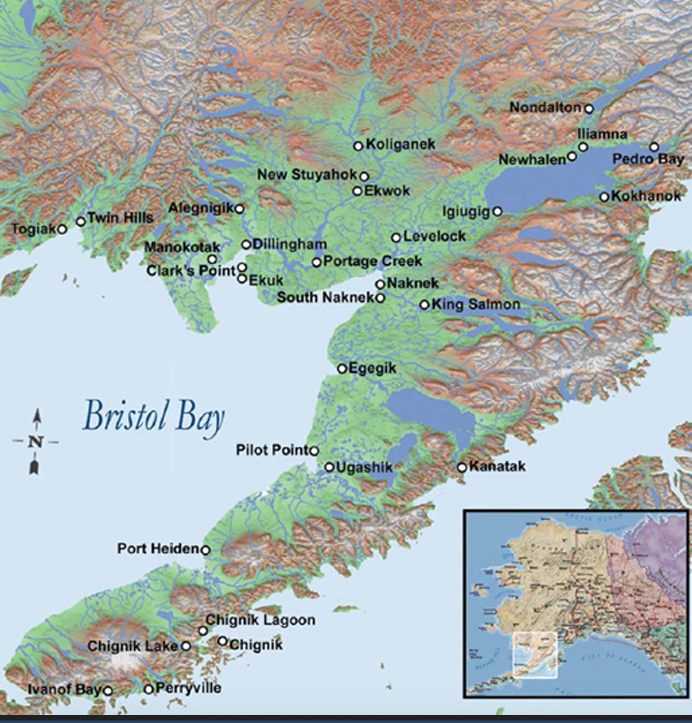
No surprise: Jawanza Brown has had some anxiety. But not about Alaska or fishing or being away from home for the first time.
“Before Buck’s offer, I didn’t know how exactly I was going to pay for all my college,” he said. “It was nerve-wracking.”
He has two younger brothers, a younger sister and two older sisters, one in a trade and one in college. They all aspire to higher, but it is not a family of financial means.
“When this offer came, I felt so blessed,” he said. “It’ll be a great relief for all of us. I like the idea of making my own money and paying my way through college.”
If he pulls it off, he will have earned it.
When the season begins, around 40 million sockeye salmon travel from the ocean to spawning grounds — “a stampede of protein,” as Gibbons calls it — in the rivers of the Alaska Peninsula. The state fish and game department tightly regulates the fishery — a protectorate of 52,000 square miles of ocean, rocky shores and unimaginable amounts of bird and sea life — by allowing the first 10 million upstream to propagate.
After escapement, mayhem begins.
Boats of all pedigrees, from decrepit beaters worth $50,000 to gleaming, technology-festooned rigs valued at more than $800,000, share three things: All are 32 feet in length (state law from 1952), all must follow a tight script of regulations, and all work every long northern day (storms permitting). The best outfits share a fourth thing: Good attitudes.
“Whether you take a kid out of Flint, Michigan or Mercer Island, it’s not easy,” Gibbons said. “To get my share of of income and for the crew, it’s as competitive as anything I’ve been a part of.
“I told Jawanza (and all first-time crew members) I know you don’t know much about fishing. I’ll teach you everything you need to know. You gotta bring a good attitude. If you don’t, you’ll be on the first plane out. I’d rather go it alone than babysit someone. It’s tough enough when everyone is hitting on all cylinders. I can’t have somebody bitching and sniveling. That’s exhausting in any workplace.”
An average day’s catch produces 15,000 to 18,000 pounds of salmon per boat, hauled off by tenders that weigh the harvest and provide receipts that will be turned into cash at season’s end. The tenders also provide groceries and fuel so boats can stay in the offshore waters for the season. A dry-land stop is rare.
“It’s like racing a stock car,” Gibbons said. “You want to be on the track, not in pit row. Half the battle is preparing.”
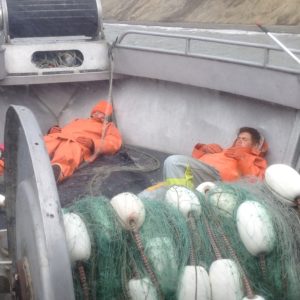
On a typical day, Gibbons gets up at 4 a.m., pulls anchor and heads to the fishing grounds, likely the mouth of the Ugashik River. Crewmen, who had precisely laid out clothes and gear for the morning, rise an hour later. They jump into preparing the deck for casting the net. Once the net is in the water, they wait from 10 to 40 minutes before rolling the net onto a mechanical drum. The crew picks the fish from the net as fast as possible and puts the catch in a hold of refrigerated sea water. If the volume merits, Gibbons joins the crew on deck.
“Manual labor, all day long,” Gibbons said. “Wash, rinse, repeat. We eat our meals together in the galley. They clean the galley and put everything away. God help you if I wake up to a sink full of dishes. That’s not happening.”
They can fish as late as the 11 p.m. sunset, then right to bed for four to five hours.
“We like to say, sleep is a weapon — use it,” he said. “You read a book, or listen on your headphones to music and not sleep, you hurt your pay.”
Gibbons sounds tough, but there’s really no choice in such an intense environment. Yet life aboard his boat is not nearly as dramatic as it seems to fans of Discovery Channel’s popular show, Deadliest Catch.
“People see abuse handed down to the crewmen, but the show is edited for its drama points,” he said. “That’s not how it works, at least in my operation. I don’t ask them to do anything wouldn’t do. I want these kids to be around for the next four or five years, so I treat them with dignity and respect. If I have to yell, that means I haven’t taught the right way.
“I find it difficult to yell at someone, then sit around a galley table 30 minutes later. It’s awkward.”
Before he flew to Bristol, Gibbons was in the gym four days a week.
“Their job is to keep up with me,” he said. “Articulated that way, there’s really no excuse — keep up with this old man.”
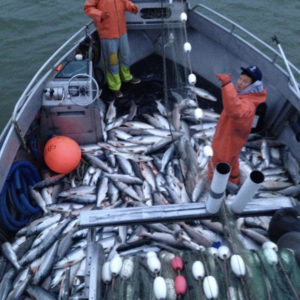
Brown was a high school football player, but missed his senior season because of an ankle broken during a summer-job accident. The ankle is fine, and the rehab experience for him was so compelling that he’s decided he wants to get a degree in sports medicine, with an emphasis on occupational therapy.
He sounded as if he is not intimidated by academics, thousands of pounds of fish or Gibbons.
“Buck left a good impression,” he said. “After meeting him, it made me really want to do this. He told me how long I’d be gone, and how far from home I’d be, but he made me feel more comfortable about it. He showed me some of the equipment, and how to work it. He was very upfront, very respectful and honest about the job. I appreciated that. I felt more like I could do it.”
Why, he was asked, do you think Gibbons wants to do this?
“Buck showed me the (Rawls) video, and said, ‘This is why,'” he said. “He was truly moved by it. He wanted to help young kids in Flint.”
Gibbons also wants to make a point with his fellow commercial boat operators, as well as any business owner who wants to do more than spectate at the decline of an American city.
“I want Jawanza to succeed,” he said. “I want some of of my peer group up there to see success, and inspire them to plagiarize the idea. Let’s get more than one kid from Flint.
“I’ll be the tip of the spear.”
Thomas Rawls said he wants to be Superman for his city. Buck Gibbons says he wants to be the tip of the spear. Jawanza Brown wants to earn his way through college.
If they find out Brown is indeed built for this, that’s another pair of hands on the rope pulling Flint back from the precipice.
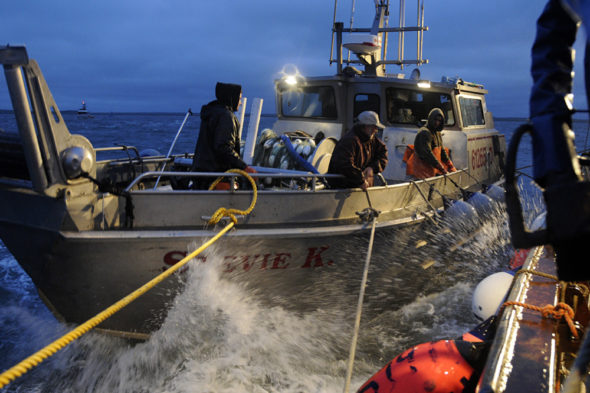

20 Comments
Great article. My friend Rory is flying up to ‘the Bay’ today. He grew up on Long Island and lives in Orlando. One of his crew is Mexican. The bay fisheries used to be Italians from San Francisco and Norwegians from Ballard. Actually, Alaska fisheries as a whole are very diverse employers; Philipinos, Samoans, Mexicans, Japanese, Vietnamese, Africans, Halos, Undetermined, you name it. I know of one processing ship to sail from Seattle with a crew of 140 with only 14 born in the United States.
i’m told the fish-processing part of the industry is diverse, but the boat crews not so much, particularly with African Americans. It’s often a matter of trying. Buck is trying.
My congrats also for the article, Art. Many years ago, as a teenager, I worked on the last DEW line sight built on Bristol and later on a salmon troller off our coast. Bristol is relatively shallow so the swell starts building well out and an inexperienced puker could have a difficult time till he overcomes it. Nobody gets much sleep on a fishing boat, but Bristol is one of those places made more dangerous with so many fishing so close and trying to work fast. Jawanza will earn what he makes and I wish him luck.
You know from where you speak, John. I was tempted in college to join friends in Bristol, because the money was good then too. But silly me, I kept working in the dry financial hole of journalism.
Excellent story Art, but then what else is new? I am in the Bristol Bay area and the fishermen are either white or native and everyone gets along. This is about work and that’s it. Not a place for slacking off, attitude, etc and as Gibbons said, those who don’t work out are on the next flight. The time is short, intense and no place for a jive.
This kid will see some of the most beautiful scenery in he world and his eyes will be opened just for that, let alone being around solid, hardworking men.
What a chance of a lifetime for this kid and I am very impressed with Gibbons. What he is doing will clearly change a life and very few of us ever have that chance.
Imagine a kid these days without internet or cell phone for months. He will see a side of life that he will benefit from for the rest of his life.
I sure hope you plan on an after-season column Art, as I am already looking forward to it.
Thanks, coolguy. Didn’t know you lived in the sockeye ‘hood. I’ve vacationed six or seven times in Alaska, so I know what you’re saying about place and people. Buck told me African Americans were scarce in the fishing fleet, but natives indeed are on boats and also get first dibs on the run for subsistence.
Indeed, there will be a follow-up.
wow, excellent, what a great article. love the depth and the detail. Kudos to Buck Gibbons for his very considerable effort, and good luck to Jawanza Brown! he sounds like a worthy young man. I hope you’ll let us know how it all turns out.
I will follow up, Tian. It would be an accomplishment to the see the work of both men lead to many more opportunities.
Excellent, in depth, inspiring article. Concept, too. Bravo.
Thanks, Howie. It’s always worthy in journalism to go long once in awhile.
Very interesting story. Thank you for work that obviously went into this. Would love to follow it as it unfolds if you get the opportunity to report updates. Thanks, Art!
I appreciate the kind words, Jamo.
Damn you Art. My mascara is running down both my cheeks. I pray this works out. Please keep us informed
I know the feeling. This has to work, y’know?
Outstanding work Art, seamlessly tying together personal stories from Flint to Bellingham to Bristol Bay.
One small typo, however. You state the number of boats in Bristol Bay as 150. The real number is closer to 10 times that. Typically there are just over 1,400 boats registered to fish during the peak of the season. Each boat has 3 or 4 people on board. That means Jawanza will likely be the only African-American in a work force of around 5,000 people.
I am headed up there Wednesday for my 35th consecutive fishing season in Bristol Bay. I’ll give the Stevie K a wave and a thumbs up if I see them on the water.
That may have been a misunderstanding. I asked about the typical number of boats in his vicinity in any one day, and Buck guessed about 150 at the mouth of the Ugashik. I didn’t ask about the entire fleet, which is as you wrote, much larger.
Congrats on your long tenure. I have often thought about the time in college I passed on a summer in Bristol. Then again, at my height, I would likely have gone overboard.